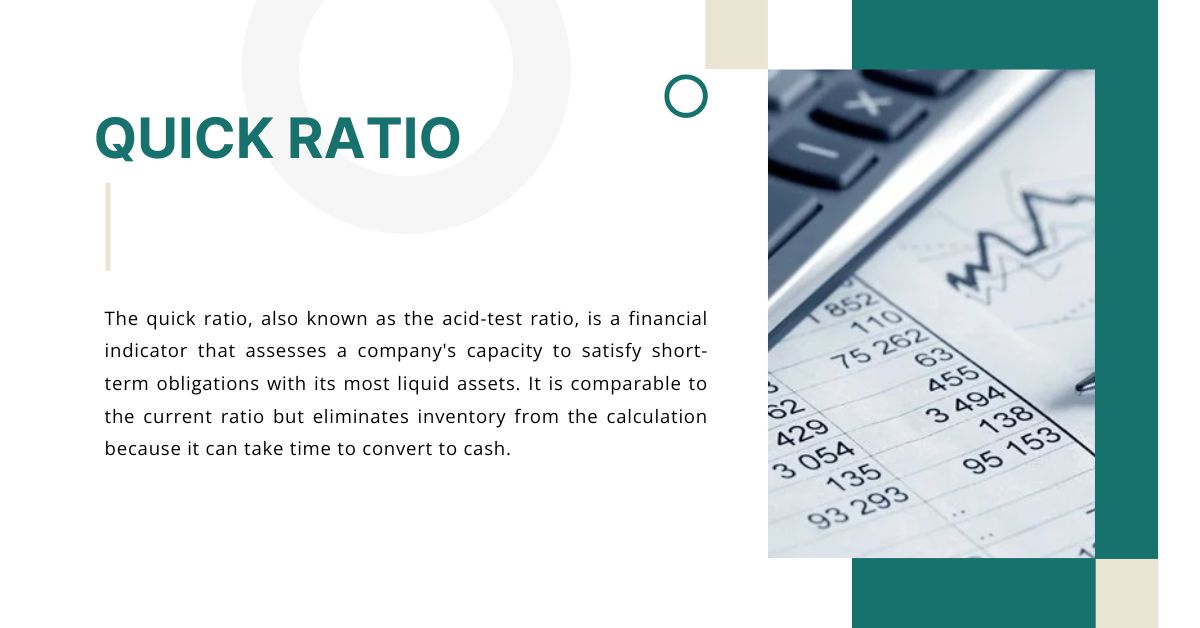The quick ratio is a financial indicator that measures a company’s ability to repay its current loans. Accountants and other finance professionals frequently utilize this ratio to assess a company’s financial health in a simple and timely manner.
What is Quick Ratio?

The quick ratio, also known as the acid-test ratio, is a financial indicator that assesses a company’s capacity to satisfy short-term obligations with its most liquid assets. It is comparable to the current ratio but eliminates inventory from the calculation because it can take time to convert to cash.
Formula for the Quick Ratio
The formula for the quick ratio, also known as the acid-test ratio, is:
Quick Ratio = (Current Assets – Inventory) / Current Liabilities
In this formula:
- Current Assets: These are assets that can be converted into cash within one year.
- Inventory: This includes the value of goods that the company has on hand and can be sold.
- Current Liabilities: These are liabilities that are due within one year.
The quick ratio is a more careful estimate of a company’s liquidity than the current ratio since it does not include inventory, which can take time to convert to cash. A greater quick ratio shows that a corporation has enough liquid assets to satisfy its current liabilities.
Who Uses the Quick Ratio?
Many stakeholders use the quick ratio as a popular financial indicator to assess a company’s financial health. Here are some of the major groups that use the quick ratio.
- Investors use the quick ratio to assess a company’s liquidity and capacity to satisfy short-term obligations, particularly in cases when inventory is difficult to sell or convert to cash.
- Creditors: Lenders, such as banks and suppliers, use the quick ratio to determine a company’s creditworthiness before issuing credit. A high fast ratio suggests that the corporation is more likely to pay its debts on schedule.
- Management utilizes the quick ratio to assess the company’s liquidity and identify potential cash flow issues. A low quick ratio may signal that the corporation should strengthen its cash management or minimize its short-term liabilities.
- Financial analysts use the quick ratio to compare a company’s financial performance to industry benchmarks and determine its overall financial health.
- Government organizations and regulatory authorities may use the quick ratio to assess the financial health of corporations in specific industries, such as banking and insurance.
Advantages and Disadvantages of the Quick Ratio
| Advantage | Disadvantage |
|---|---|
| More conservative measure of liquidity: Excludes inventory, which can be less liquid than other current assets. | May underestimate liquidity: If inventory is highly liquid, excluding it can overstate liquidity concerns. |
| Useful for industries with high inventory levels: Provides a better assessment of liquidity for companies with large inventory holdings. | May not capture seasonal fluctuations: If inventory levels fluctuate significantly throughout the year, the quick ratio may not provide a complete picture of liquidity. |
| Can be used in conjunction with other ratios: Provides valuable insights when used in combination with other financial metrics, such as the current ratio and working capital ratio. | May not be relevant for all industries: The relevance of the quick ratio may vary depending on the nature of a company’s business and its industry. |
Quick Ratio vs Current Ratio
| Feature | Quick Ratio | Current Ratio |
|---|---|---|
| Definition | Measures liquidity using most liquid assets, excluding inventory. | Measures overall liquidity using all current assets. |
| Formula | (Current Assets – Inventory) / Current Liabilities | Current Assets / Current Liabilities |
| Focus | Immediate liquidity | Overall liquidity |
| Relevance | Industries with high inventory levels | Most industries |
| Interpretation | Higher ratio indicates better immediate liquidity | Higher ratio indicates better overall liquidity |
Why Is It Called the Quick Ratio?
The term “quick ratio” refers to a company’s most liquid assets, which can be swiftly transformed into cash. In contrast, the current ratio considers all current assets, including inventories that may take longer to sell.
The quick ratio is intended to provide a more careful assessment of a company’s liquidity, particularly for those with important inventories that are difficult to sell or convert into cash rapidly. By removing inventories from the computation, the fast ratio concentrates on assets that can be easily transformed into cash to fulfill immediate needs.
Why Is Quick Ratio Important?
The quick ratio is important because it provides a more cautious estimate of a company’s liquidity than the current ratio. By removing inventory, which can take time to sell or convert into cash, the quick ratio concentrates on the most liquid assets that a company can use to satisfy its immediate liabilities. This is especially significant for businesses with big inventories or in industries where inventory is difficult to sell.
A high quick ratio implies that a corporation has enough liquid assets to cover its short-term loans, which is usually a good indicator. This might be crucial for investors, creditors, and management because it indicates that the company is less likely to experience financial troubles. To acquire a holistic picture of a company’s financial health, the quick ratio should be analyzed with other financial measures and industry benchmarks.
How Your Company Can Use the Quick Ratio?
The quick ratio can help you measure your company’s short-term liquidity and financial health. Regularly calculating and monitoring the quick ratio allows you to spot possible cash flow concerns and take proactive steps to fix them.
Here are several ways your business can use the quickly ratio:
- Monitor liquidity: Monitor your company’s quick ratio over time to analyze variations in liquidity and detect potential patterns.
- Compare to industry benchmarks: Compare your company’s quick ratio to industry standards to see if you’re doing better or worse than competitors.
- Consider financing options: Use the quick ratio to determine your company’s potential to secure additional financing or negotiate favorable terms with lenders.
- Make informed business judgments. Consider the quick ratio while deciding on investments, acquisitions, or other strategic activities.
- Identify areas of improvement: If your quick ratio is low, consider ways to boost your company’s liquidity, such as lowering inventory levels or improving collections.
What Is a Good Quick Ratio?
A “good” quick ratio varies according to the industry and a company’s individual circumstances. A quick ratio of 1 or greater is generally regarded as healthy, showing that a corporation has enough liquid assets to meet its short-term obligations.
However, industries with significant inventory turnover, such as retail and manufacturing, may have lower optimal fast ratios. A ratio less than 1 indicates that a corporation may have difficulties meeting its immediate debts, particularly if its inventory is difficult to sell or convert into cash.
Is a Higher Quick Ratio Better?
In general, a higher quick ratio is considered better. This suggests that a company has more liquid assets to pay its short-term obligations, which is good news for its financial health. A greater quick ratio can boost a company’s creditworthiness, making it easier to get funding and negotiate better terms with lenders.
However, a very high quick ratio may indicate that the company has too much cash or other highly liquid assets, which could be less profitable. Furthermore, the appropriate fast ratio varies depending on the industry and the company’s specific conditions.
Finally, a corporation should seek to maintain a quick ratio that is enough to cover its short-term loans while also making optimal use of its resources.
What Does a Quick Ratio Under 1 Mean?
A quick ratio below one indicates that a company’s current obligations exceed its most liquid assets. This suggests that the company may struggle to meet its immediate obligations, such as bill payment and short-term debt repayment.
A low quick ratio might indicate financial trouble, raising concerns among investors, creditors, and management. The company may face difficulties in obtaining additional financing or negotiating acceptable terms with suppliers. In extreme circumstances, a consistently low quick ratio can lead to insolvency.
However, a low quick ratio is not always cause for urgent concern. Factors to examine include industry norms, business models, and overall financial health. For example, a company in a fast growing industry may have a smaller quick ratio as a result of higher inventory or fixed asset investments.

